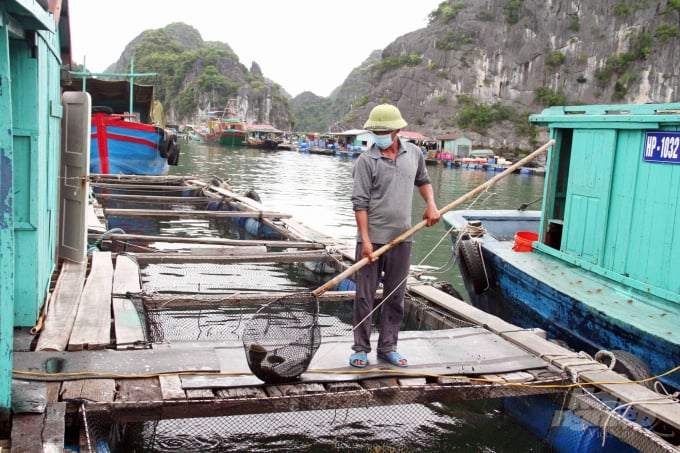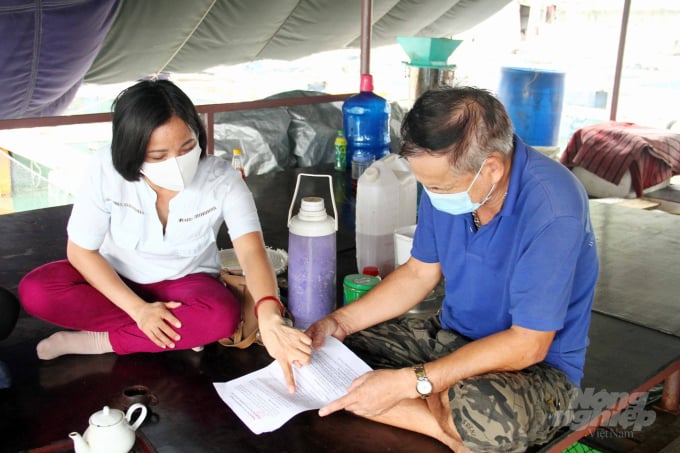November 7, 2025 | 07:46 GMT +7
November 7, 2025 | 07:46 GMT +7
Hotline: 0913.378.918
November 7, 2025 | 07:46 GMT +7
Hotline: 0913.378.918
Hai Phong City has recently decided to fund more than VND68 billion for removing 60,000 fish farm cages in Cat Ba with the aim of leveraging tourism development.
Accordingly Hai Phong will reduce the number of fish farm cages in Tra Bau Bay, Lan Ha Bay and Cat Ba Bay towards ending cage aquaculture to ensure landscapes and environment, making a breakthrough in the protection of landscapes.
This is considered as one of the solutions for solving the problems of removing unsuitable fish farm cages from Cat Ba Bay. It’s expected that the solution will help deal with existing issues of developing aquaculture and preserving and protecting ecological environment and landscapes.

Thousands of tons of seafood in Cat Ba can’t be sold. Photo: Dinh Muoi.
Cat Hai district has sent a letter to the relevant agencies, calling them to help with seafood consumption during the implementation of the project on cutting down, removing sea cages from Cat Ba islands.
In addition, the People’s Committee of Cat Hai district assigned the Office of Economy and Infrastructure to assume the prime responsibility, cooperating with the Office of Agriculture and Rural Development, the Station of Aquaculture Extension – Agriculture, Board of Management of the bays in Cat Ba islands to connect buyers to fishermen.
Although there were financial aids, specific regulations and the help from agencies and enterprises, seafood consumption faced a lot of difficulties. Currently, as the first sea cages are about to be removed as planned, less than 1% of seafood cultivated here are sold. The number of enterprises registering for purchasing seafood is just nearly 12%.
“Only 20 tons of seafood have been sold. The enterprises have just registered the volume of their purchases but it’s not clear on when they will come to buy and what type and what quantity they want. They have just registered to buy 700 tons of seafood. We are also mobilizing other channels but it doesn’t work. We worked with several big companies like Sun Group, Vinfast, Dinh Vu industrial zone and Hai Phong Port but they can consume a small quantity,” said Hoang Trung Cuong, Vice Chairman of Cat Hai People’s Committee.
According to Cat Hai People’s Committee, there are 440 aquaculture establishments with 516 huts, 8,216 sited rafts and 58,790 square meters of suspended rope farms mainly in Cat Ba Bay, Lan Ha Bay, Ben Beo Bay, Tra Bau Bay and Gia Luan Bay.
The total fish production needs to be sold is more than 2,200 tons. The total volume of mollusc is over 4,200 tons. In the phase 1, from now until the end of 2021, Cat Hai district plans to remove 231 huts, 3,918 cages and 58,000 square meters of suspended rope farms at Lan Ha Bay and Tra Bau Bay.
The enterprises and people in Hai Phong City mostly have the spirit of helping Cat Ba fishermen with consuming seafood.
However it’s difficult because seafood prices are now higher than fresh water fish that local people used to eat. In addition to this, the shutdown of restaurants and hotels due to Covid-19 has also affected the consumption.

Many fishermen have to stay and look after their fish cages because they can’t sell their harvests. Photo: Dinh Muoi.
Do Van Toan, owner of a sited raft farm and also a big seafood trader in Cat Ba said his family had around 40 tons of seafood left. Although he has worked as a supplier of seafood products from Quang Ninh to Da Nang for more than 30 years, he could sell only 2-3 tons over the past few months.
Like Toan, hundreds of households in Cat Ba have faced the same situation. Over the past months, they were unable to sell their harvests or could sell with a small quantity while they had to spend hundreds of millions of dongs on feed including industrial feed and live bait.
“We are assigned to buy seafood for the households who have to remove their fish cages and local authorities pledge to find the market. However, it is still on paper not in reality. Currently, there are several units mainly administrative agencies coming to buy seafood but they can buy one or two quintals,” said Toan.
Also according to Toan, approximately 30% of households with cages agreed to dismantle their establishments and they almost sold out their harvests. Meanwhile others although agreed with the policy they couldn’t sell their harvest, so they had to stay to look after their cages.
Many households that are now facing difficulties due to Covid-19 and decreasing seafood prices want to return to the mainland. However, they can’t sell their fish, meaning that they can’t remove their caged and “throw fishes into the sea”
Not only Toan but also senior seafood traders in Cat Ba are now stuck on finding ways to consume over 6,000 tons of seafood for fishermen in the context of the Covid-19 outbreak. Some traders who used to sell more than 1,000 tons of fish in 2 or 3 months are now standing still.

Many households have to spend nearly VND1 billion on fish feed per month. Photo: Dinh Muoi.
“Previously, I delivered seafood from Da Nang to Quang Ninh. I could sell thousands of tons of seafood on average in the summer. In the context of the Covid-19 pandemic, customers are paying only half. If the sale of seafood is not good they won’t pay the rest. Our goods are almost frozen,” said a seafood trader in Cat Ba.
The prices offered by Cat Hai district are reasonable because the districts discussed with fishermen and traders carefully before. However businesses and people are now still hesitant to buy as the economy are affected by Covid-19 and they don’t want to spend money on expensive seafood products.
Seafood consumption is now the biggest problem posed to not only Cat Hai district but also aquaculture farming households in bays when they are going to remove their cages and sited raft farms according to Resolution No.5 of the People's Committee of Hai Phong City.
However with the current situation of seafood consumption, the removal of sea cages will certainly face a lot of difficulties because a large quantity of seafood cultivated in the area is without a stable market.
“It is now impossible to sell fish quickly. The lowest price is VND80,000 per kilogram for bronze croaker and the highest is VND140,000 per kilogram for cobia. I’m worried that it’s hard to sell fish priced above VND100,000 per kilogram to industrial zones because of many reasons related to caterings. The industrial kitchens like this are using fresh water fishes priced at VND40,000 per kilogram so they are not willing to buy fish that are two or three times more expensive. Businesses want to support the city’s policy but they have to think of the economic issue as well,” sadly said Dinh Nhu Dang, a fisherman with nearly 50 tons of seafood unsaleable.
Many sea cage owners in Cat Ba said that they supported the city’s policy of removing sited raft and suspended rope farms to re-plan new aquaculture farming areas.
However the city should not insist on keeping the process of the removal in the context of the Covid-19 outbreak. It’s necessary to consider process delay to create favorable conditions for cage owners because they are now hit by trouble from all sides as the seafood market is frozen by the Covid-19 pandemic.
Translated by Mai Tham

(VAN) Scientists and policymakers say biotechnology, digital transformation, and organic farming are key to helping Vietnam’s coconut industry adapt to climate change and enhance sustainable export value.

(VAN) Combined with fierce competition from other coconut-producing countries and limited adoption of modern techniques, the Mekong Delta’s coconut sector faces an urgent need for transformation.
/2025/11/05/3030-3-092207_368.jpg)
(VAN) Can Tho has advantages to become the regional hub for diversified fisheries development, gradually establishing a sustainable value chain linked to deep processing and export.

(VAN) To contribute to the new rural development program, Quang Ngai is focusing on developing OCOP products in a more in-depth and sustainable manner.

(VAN) An Giang expands the model of marine fish farming using HDPE cages following VietGAP standards, linking production with consumption and eco-tourism, contributing to the development of a green economy in coastal and island areas.

(VAN) Chu Yang Sin National Park announces an invitation for investment in forest environment leasing for sustainable eco-tourism business during the 2021-2030 period.
/2025/10/31/4209-2-132711_708.jpg)
(VAN) In the future, SNE Company hopes to contribute to Viet Nam's vision of 'digital agriculture – green economy – sustainable growth.'